
Jungle warfare
Hundreds of pest plant species—many of them garden escapees—run rampant in New Zealand’s biggest city. Now, its citizens are fighting back.
Sweat drips down Richard Margesson’s brow as he rappels down the slope. It’s a scorcher day on Waiheke Island. Cicadas thrum, the sun beats on the grassy cliff overlooking the boats of Oneroa Bay. But Margesson has no time for sightseeing. His objective is to free about 50 native seedlings from the clutches of a mortal enemy.
It takes a good half-hour, but the mission is successful. The roped-up assassin returns to the safety of flat ground. He’s a Bear Grylls character, an army veteran decked out in khaki. Margesson, a Brit nicknamed Mad Major, has spent the past few years bringing his military skills and tactics to a new battle here on Waiheke. “We’re not fighting humans—thank god—but rather fighting a biological enemy,” he says.

It’s a war on weeds in what may be the world’s weediest city. In Auckland, the warm and wet climate, combined with plentiful gardens, creates the perfect recipe for a weed invasion. It’s thought the city has more invasive plant species than any other in the world: nearly 300 have made it onto Auckland Council’s list of most wanted, from bogbean to devil’s fig to pampas.
To put this in context: New Zealand is home to around 2300 native plants. Humans have introduced a further 25,000-30,000 plants from overseas—some inadvertently, but many on purpose. Around 1800 of these exotics have gone rogue, establishing a foothold in the wild—their numbers swell by about 20 new plants every year. Most of these interlopers started out growing in our gardens. Four hundred or so are managed as weeds at a cost of $1 billion annually.
On Waiheke, a weed hotspot, the battle is in full swing. Margesson and his crew of eight are contracted to focus on six species: moth plant, woolly nightshade, evergreen buckthorn, climbing asparagus and two types of ginger. This morning in Newton Reserve, the crew have already tackled a gnarly moth plant infestation. A crew member brandishes a root curled into a wreath. “We have a gift for you!” she says. The root is moth plant and it’s three fingers thick, representing about 8–10 years of growth. “They know I like trophies. I hang them up outside my front door,” says Margesson.
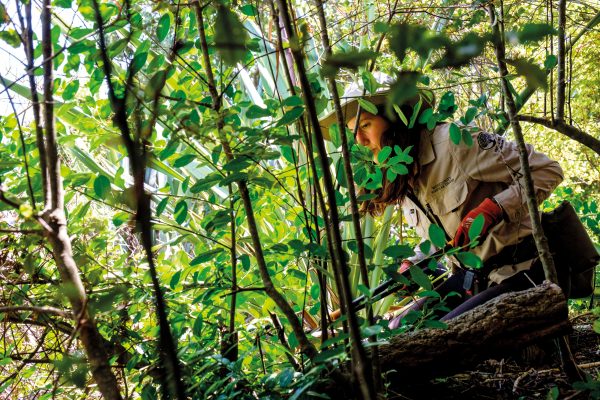
Margesson compares pest plant control to jungle warfare, and draws on the concept of grid clearing to systematically purge pest plants across 51 nature reserves on Waiheke, covering just under 3000 hectares. The crew will march through a grid, free every tree of any pest plants present and get them down onto the forest floor. A second grid-march disposes of the enemy—a cautious approach that minimises herbicide use and reduces friendly fire. These grids are surveyed each year until any seeds lying dormant in the soil have been exhausted. “That’s how we win,” says Margesson. “It’s a war of attrition.”
[Chapter Break]
What exactly is a weed? While Western perspectives zoom in on individuals—a weed is a plant growing in the wrong place—te ao Māori takes a wider view.
Environmental researcher Amanda Black (Tūhoe, Whakatōhea, Whānau a Āpanui) notes that plants we might consider weedy could be valued by Māori. (Pūhā, a traditional staple, is a classic example.)
“Different iwi and hapū have different issues and values,” she says. “And they often take a pragmatic approach: is it a weed or is it a feed?
“An overarching view would be how a plant fits into the ecosystem. In an ideal world we’d return everything to natives. But in reality, some of these species have utility for the ecosystem and for people. For example, in Waikato-Tainui, weeping willows provide shelter for native fish, so they are accepted.”

In other places, introduced but not particularly weedy plants can act as hosts or reservoirs for pathogens such as myrtle rust and kauri dieback, making their control more of a priority for iwi or hapū.
The whakapapa of an ecosystem might also be a concern, says Black. For example, an introduced ice plant can hybridise with a native ice plant, traditionally used in rongoā (medicine), changing its whakapapa and potentially its rongoā properties.
As Pākehā rongoā authority Rob McGowan wrote in a recent report: “From a Māori perspective it could be said that a weed is a plant that upsets the balance that Papatūānuku needs to be well.”
The steady march of such pest plants across our landscapes is a slow-motion ecological disaster, smothering and stifling natives. “Things like privet, Taiwan cherry and sycamore can just replace the canopy entirely, out-competing native seedlings and becoming the dominant tree species. It forms a monoculture,” says Margaret Stanley, an ecologist at the University of Auckland. It’s not just the tree communities that transform—our native invertebrates might not find the exotic species tasty. Forests collapse. Changes cascade through the ecosystem.
Some weeds can change the chemistry of the soil, making it easier for other weeds to invade, or even preventing other plants from growing altogether. “Rhododendron makes the soil toxic, and after they’ve been removed, you can’t replant anything,” says Stanley. “It’s a massive problem in the UK.”
It’s not just native biodiversity that suffers under the burgeoning pest plant regime. Agriculture and primary production are impacted. And people and their pets get injured too—for example, phoenix palms have large spikes, and the sap of the moth plant can cause allergic reactions. Over the past decade, ACC has received 6600 claims related to pest plants at a cost of more than $3.2 million.
[Chapter Break]
It looks like a deformed pear, or an alien egg. It’s fist-sized, green and slightly wrinkled. Inside its leathery flesh are 1000 black seeds attached to feathery wisps: parachutes, to help each seed disperse up to 20 kilometres from the parent. This is the seed pod of the moth plant, a climber originally from South America. The vine, introduced to clamber prettily over garden fences and trellises, now coils its way up native trees and shrubs, strangling and smothering. Snap its stem and that milky, poisonous sap oozes out.
Moth plant is a gateway weed, says Richard Henty, a science teacher and founder of the Society Totally Against Moth Plant (STAMP). It’s one of the first weeds people notice, with its white flowers and eye-catching seed pods. Plus, you can just pull out the roots and watch the vine wither and die, Henty says. “No need for chainsaws or spades or lots of weaponry.”
Henty first encountered moth plant on Motuihe Island, and then began seeing it everywhere he looked. He took his students out on short trips around the neighbourhood to tackle it. This soon became a hobby, something he did on the weekends. “I wondered if there were other people out there who shared the same bonkers idea of getting rid of moth plant,” he says. There were: the STAMP Facebook group now has 2500 members, with a core group who “put in a fair crack of hours”. Moth plant sightings are loaded onto a map which now features 18,000 locations. “Last year, we managed to check 8000 or so locations,” Henty says.
The moth plant mania has spread with competitions for schoolkids springing up across Auckland and prizes for whoever can collect the most seed pods—a couple are kicking off in March in Howick and South Auckland. And it’s also on the hit list for community groups who use long-handled pod-grabbers, nipping the seed-bombs off the vine before they can explode.
“It’s so evil. It’s a plant you love to hate,” says Josh Salter, who is part of Pest Free Kaipātiki’s (PFK) hit squad. This small but dedicated team of retirees hits the pavement on a Monday morning, door-knocking houses in ‘buffer zones’ around North Shore reserves and asking, “Can we see your backyard?”
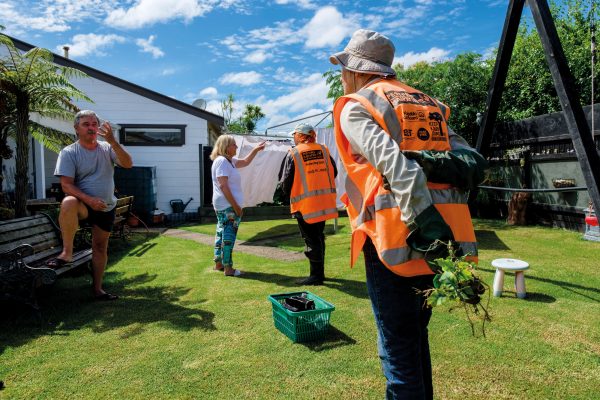
Usually, the answer is yes. “Most people are nice,” says fellow door-knocker Anne Denny. And they want to help—Denny reckons there’s a lot more awareness of “the menaces of weeds” than there was 15 years ago. “It’s a big thing to win hearts and minds.”
It’s a hot summer morning and Salter and Denny are canvassing a quiet cul-de-sac. They are dressed in fluoro orange hi-vis (which matches Salter’s bright-orange hair) and open-carry cut-and-paste herbicide in holsters. The pair stroll down the street, peering down driveways, alert for any sign of moth plant or woolly nightshade. They knock on a door, but before the occupant even answers, Salter and Denny are doubled over extracting moth plant seedlings from between gaps in the veranda. The duo continue removing the plants as they introduce themselves and hand over mugshots of noxious weeds.
The next-door neighbour emerges. “Good to see you back again,” he says. He’d met the PFK hit squad last year, and is now firmly on the weed-busting bandwagon. He wants to show Salter and Denny the woolly nightshade and moth plant that are creeping over his back fence from the neighbour’s place.
The morning concludes with a free-for-all weeding session in the nearby reserve. On a slope, moth plant creeps under cover of long grass and corkscrews up flax and cabbage trees. A group of four are elbow-deep in the grass, disentangling the moth plant vine like a giant spool of knotted thread. “How do you even find the root?!” someone groans.
But while the work of weeding is taxing, it’s also rewarding—even more than tree planting, says Salter. “You can immediately see the difference with weeding. Big ones wilt, small ones rooted out form big piles.” By contrast, she says, newly planted trees spend a while just looking miserable.
And once you embark on the weed life, it becomes all-consuming. “My wife no longer goes on walks with me, because I stop so often to pull out the weeds,” one hit squad member says.
[Chapter Break]
There’s no shortage of front-line action from both community and contractors across Auckland. But New Zealand’s current situation is more guerrilla group rather than a well-oiled military machine. In his November 2021 report Space invaders, the Parliamentary Commissioner for the Environment, Simon Upton, dug deep into the weed problem, finding a lack of national leadership and overarching strategy. On-the-ground intelligence often isn’t shared between allies, he found, and “reports from the front line often depend as much on luck as systematic surveillance”.
These are issues Keith Salmon has encountered for more than 10 years on his pest plant quest. Salmon is a founder of the Environmental Weed Coalition (EWC), a collective set up in response to the Space invaders report.
“In Auckland, there’s a lot of duplication of effort and lack of focus on particular issues,” he says. He would like to see a coordinated system that gives community, council and contractors visibility on each other’s efforts. One such solution could be mapping with geographic information systems, where “data can just be recorded and layers shared between appropriate groups, providing a view that doesn’t reveal confidential or commercially sensitive data”.
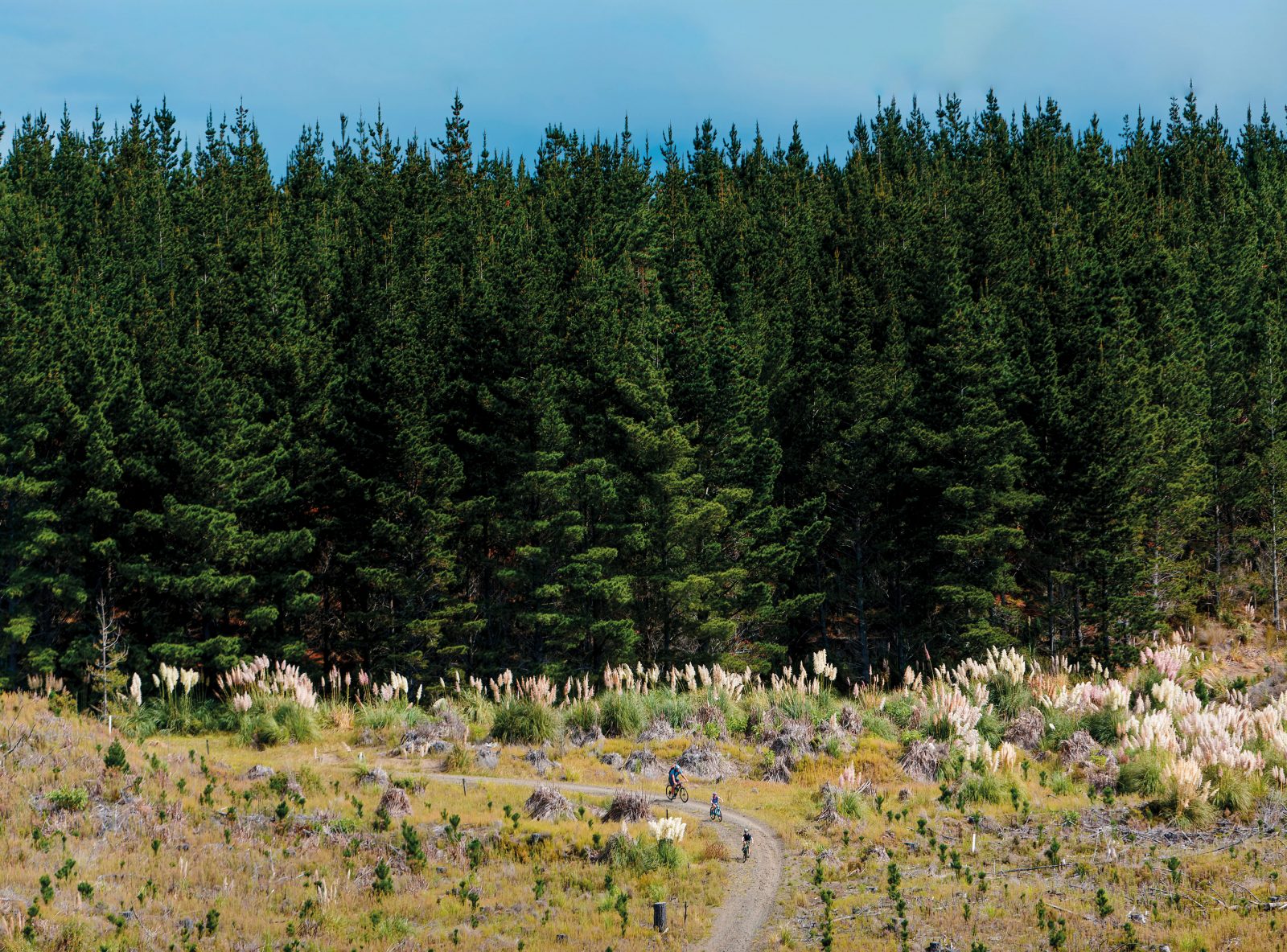

In this vein, the EWC has developed the CAMS Weed App. Users log the coordinates of weed infestations and receive automatic prompts to check them regularly. Different colours indicate the status of the site: red means a weed has been reported and purple means the site hasn’t been revisited recently. A green diamond indicates an ‘all clear’ visit and yellow signifies that the weed has been taken out. This is the mapping tool STAMP uses, and Henty says it’s a “measles fest” of red and purple dots of moth plant.
But beyond specific tools, Salmon would like to see a national approach to pest plants that mirrors the Predator Free 2050 strategy—minus the end-date, because we’ll never be fully rid of weeds. Could a weed-free movement mobilise thousands of New Zealanders (and millions of dollars) to tackle pest plants, like Predator Free has for a handful of invasive mammals? Upton writes in his report, “No such focused call to arms exists on the weeds front… even the most triffid-like stranglers, such as wild ginger (Hedychium sp.) or climbing asparagus (Asparagus scandens), are unable to arouse a sense of outrage the way that a stoat filmed eating a kiwi chick can.”
[Chapter Break]
The stream is bordered by a blaze of orange. Water burbles over white blooms and blue-flowered vines curl up trees. All three of the eye-catching species are pest plants: Montbretia, oxygen weed and blue morning glory. All three are garden escapees. “You can see why people wanted to plant these, they’re so pretty,” says Bella Burgess from PFK.
We’re at an undisclosed reserve in Auckland to see another household favourite gone rogue: Tradescantia, or wandering willie. This shade-loving species forms dense, glossy carpets in the undergrowth. But here and there you can see patches where the carpet is worn bare and native seedlings peek through. These holes are thanks to an unlikely ally enlisted in the war on weeds: a beetle. Or three.
“One of the reasons plants can become so invasive is that we tend to bring them in nice and clean, so they don’t have all the things that would be eating them back home,” says Imogen Bassett, principal advisor for biosecurity at Auckland Council. The solution? Bring in the leaf-eaters.
Introducing a new species deliberately might seem crazy after the disaster that was bringing in mustelids to control rabbits, but Bassett says the process is extremely rigorous. “They have to be really specific. It often takes 8-10 years of research to bring a new biocontrol agent into the country and we have good processes for testing what they will and won’t eat.”
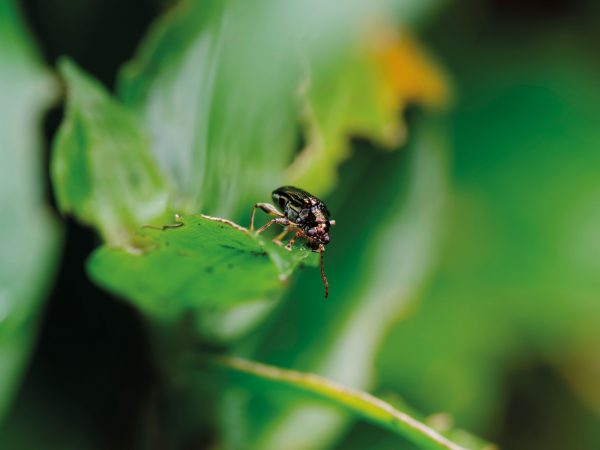
If the would-be biocontrol agent—usually an insect or a fungus—fails these tests, it won’t be released. But three species of Tradescantia-munching beetles did pass, and marched onto the battlefield in 2011. Nicknamed ‘Shiny’, ‘Knobbly’ and ‘Stripy’, the three species target different parts of the plant: the leaf, tips and stems. Today, we see only Shinies, the metallic bronze leaf-eating beetles, which are a little bigger than a house ant, nibbling away at the leaf edges.
“The beetles thin the vegetation out, reducing the amount of herbicide we need to use and making removal more doable for community groups,” says Burgess. Plus, they create gaps for natives to reclaim territory.
About 40 different types of biocontrol have been approved and released in New Zealand, including mites, moths and even a butterfly, targeting a variety of pests from broom to privet.
[Chapter Break]
With close to 300 plant species listed under the Regional Pest Management Plan, Auckland Council is using every weapon in its arsenal, including biocontrol, in the war on weeds. But the scale of the problem necessitates a pragmatic approach. Some species, like privet, have bolted. Others receive “sustained control” to keep their spread in check (moth plant is in this category).
The focus isn’t just on individual pest plant species, though, Bassett says. “It’s about where we can protect from pest plants.” In places with high ecological value, such as the Hunua and Waitākere Ranges, they’ll target all weeds no matter their spread status. On Aotea/Great Barrier Island, moth plant is still relatively sparse, so a local eradication could be possible.
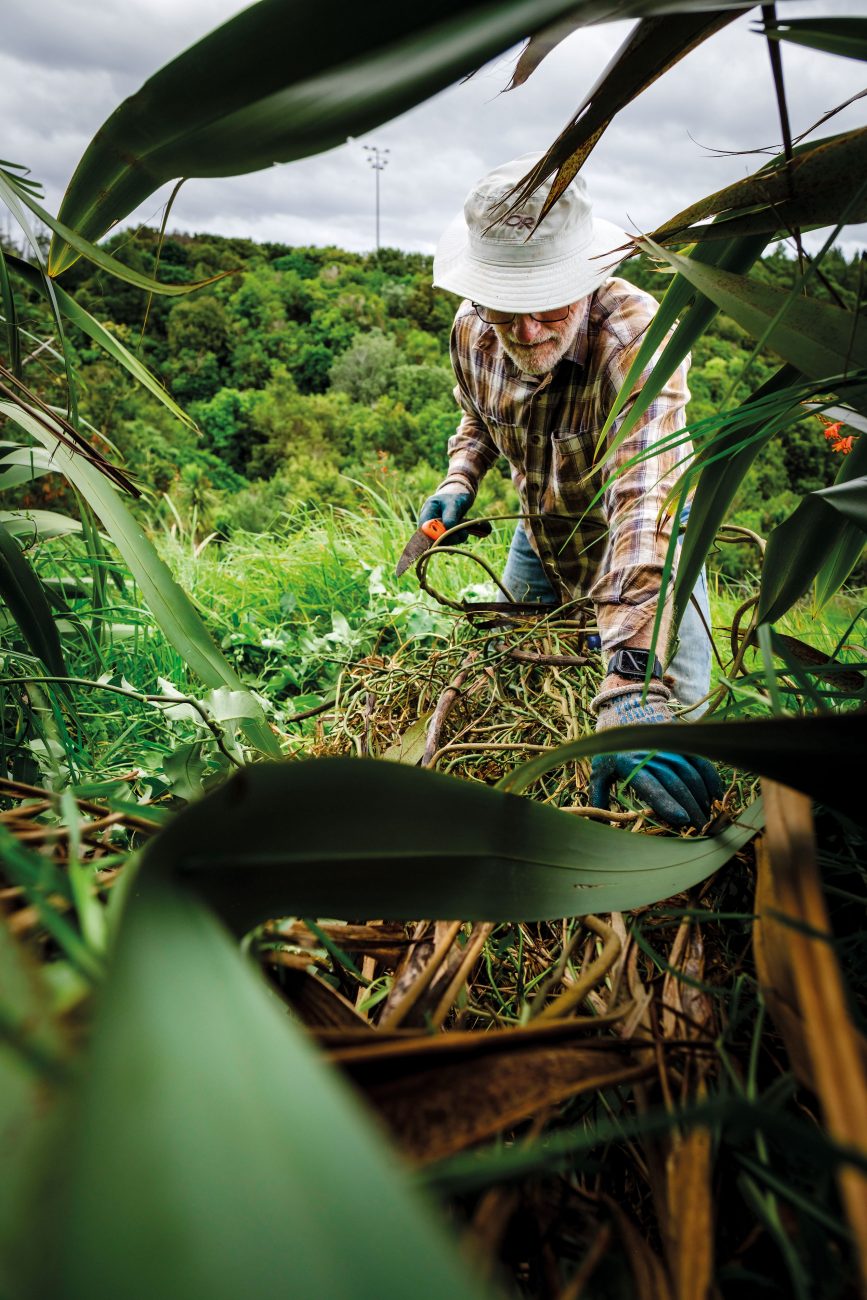
Ultimately, “the focus is on preventing the next moth plant”, says Bassett. There are 30 or so species with small enough populations that eradication is possible, like the knotweeds. “In the UK, knotweeds are notorious for bringing down people’s property prices because they get into the foundations and wreak havoc. And they’re really difficult to control. So we don’t want things like that becoming widely established here,” says Bassett. She says the council is close to eradicating a handful of species from the entire Auckland region—a rare win in the war on weeds. “I’m really optimistic that maybe this time next year, we might be able to announce some eradications.”
Often, plants aren’t weedy straight away. It can take a while—sometimes up to 100 years— for a plant to cross that threshold, and until then, they’re called ‘sleeper weeds’.
Just like a sleeper agent, a sleeper weed lurks under the radar before activating. The classic example, says Stanley, is the Bangalow palm, which was first introduced to New Zealand in 1898 but started a self-sustaining wild population only in 1992. This time lag between arrival and ‘jumping the fence’ can be chalked up to inherently slow growth: it takes a long time for the Bangalow palm to set seed and reproduce.
But other plants can be sleeper weeds for different reasons. Sometimes we don’t notice a weed until it is widespread. And sometimes it’s simply a numbers game: the more we plant something, the more opportunities for proliferation.
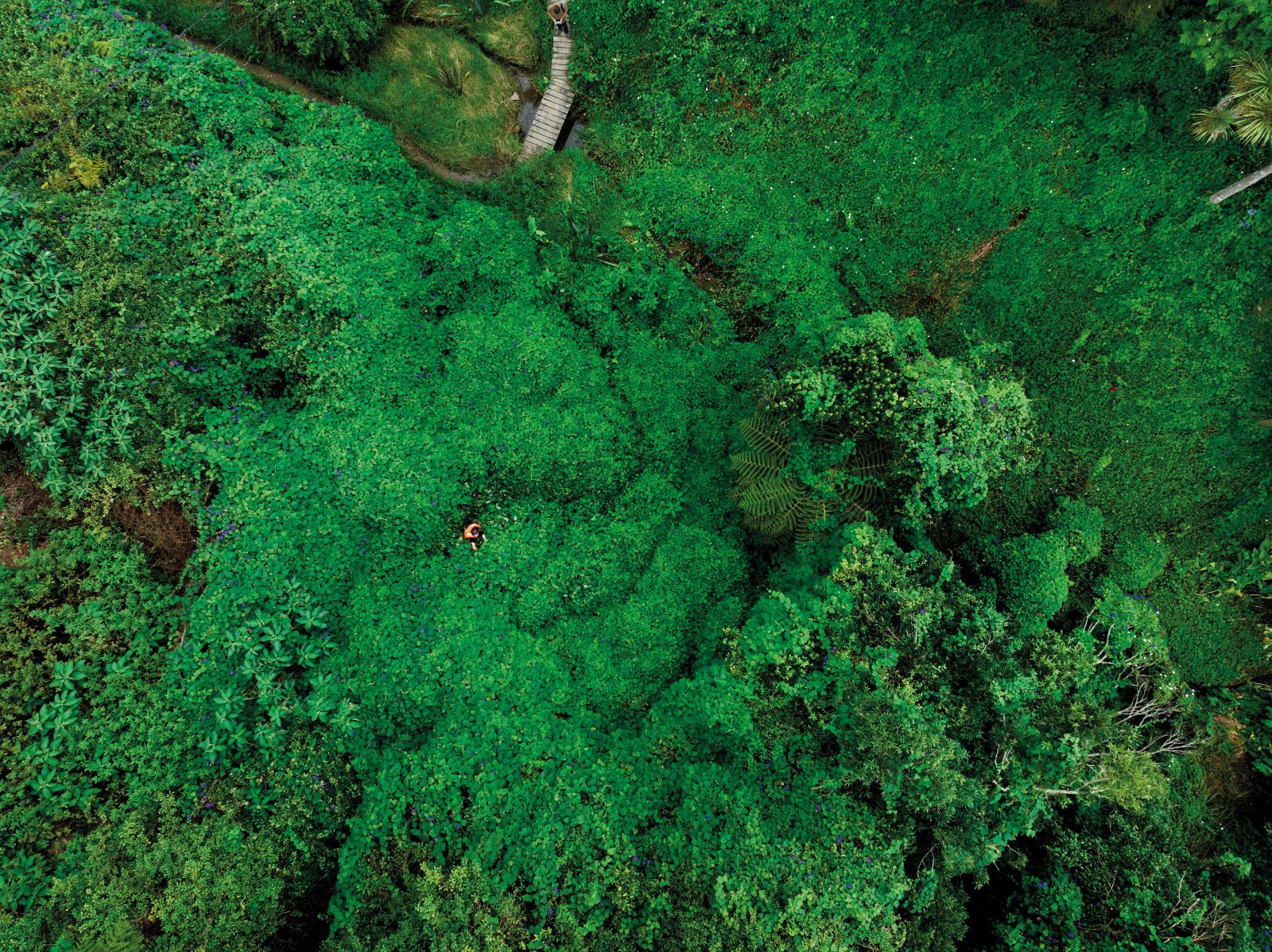
In other cases, the switch from sleeper to active can sprout from environmental changes—such as a change in soil nutrients, or the sudden appearance of a pollinator species (for example, the arrival of the fig wasp in the 1990s meant Moreton Bay fig trees could reproduce—see issue 35, Jul-Sep 1997). With climate change, Stanley says, we will “absolutely” see more sleeper weeds activate. “Just one or two days less frosty in a year in Auckland could mean that things survive the winter,” she says. “They’ll go south, and they’ll go up.
“Obviously, we can’t wait for 150 years to figure out if something’s weedy,” says Stanley. And even if you do, changing the status of a prized garden ornamental can pose problems.
When Auckland Council tried to add the Bangalow palm to the Regional Pest Management Plan in 2006, it was met with legal challenges from palm growers and sellers. As a result, Bangalow palms weren’t declared a pest back then, and were instead added to a list of ‘research organisms’. The palm became a PhD topic for University of Auckland student Christine Sheppard. She gathered evidence that eventually contributed to it being added to the banned list in September 2022.
“But we can’t have a PhD student for every weed,” says Stanley. We need risk assessments, she says, that consider a range of criteria, including the origin of the plant, whether it’s a climate match, and characteristics such as shade tolerance and climbing ability.
While researchers and decision-makers track the emerging weed threats like incoming enemies on radar, others patrol the front lines for pests on the move.
[Chapter Break]
It’s early on Sunday morning and the Avondale markets are already humming. People wheel trundlers loaded with fresh produce between stalls. Danielle Hancock and Bobbie Hanson stroll and peruse the offerings—but they’re not here for a spot of grocery shopping. They’re on high alert for pest plants on the council’s banned list.
The pair are from New Zealand Biosecurity Services Ltd and are contracted to carry out inspections and trade monitoring on behalf of the council—checking to make sure sellers aren’t inadvertently spreading pest plants even further than the birds can take them. The work requires remembering a lot of plants: “We test each other with flash cards,” says Hancock.
The first pest plant is spotted: a bundle of leaves, heart-shaped with a pungent fishy odour, laid alongside bunches of spring onion. It’s houttuynia, a herb that can form dense colonies and suppress native seedlings. “This one can’t be sold; we have to take this one,” says Hanson. “But you’re not in trouble; there’s no fine.” Hancock bundles the leafy bunch into a tote bag while Hanson fills out a form.
The original pest plants came with British colonists bringing the tastes and aesthetics of home. As New Zealand’s population diversifies, other cultures are doing the same.
Houttuynia is used in Chinese medicine as a COVID-19 remedy, so sometimes people are “distraught” when it has to be confiscated, Hancock says. Not this morning, though—but there is a language barrier. The pair carry a well-worn sheet of phrases translated into a dozen different languages. “We always have to be friendly; this is about education,” says Hancock. The morning yields three sets of houttuynia, a couple of prickly pear cactuses, soap aloe and elephant ear.

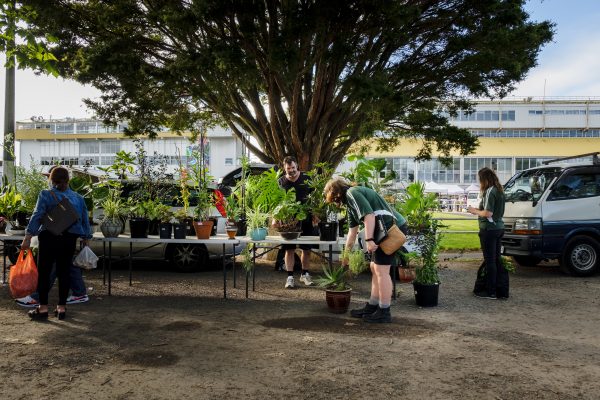
Last year, the plant-du-jour at the markets was turkey berry (also known as devil’s fig), which has pea-sized, eggplant-y fruits used in Asian cuisine—but also forms impenetrable thickets. It’s illegal to grow, sell or distribute turkey berry in Auckland, but you can buy the fruits frozen at the supermarket. Or you can drive up state highway one to Northland, where turkey berry is farmed—a frustrating example of how disjointed weed management can be around the country. Today, Hancock and Hanson don’t find any turkey berry. It’s a sign that perhaps their outreach last season was successful. Or that sellers have moved underground.
Of course, markets aren’t the only places people sell plants: Hancock and Hanson visit nurseries and monitor what’s being traded online, too. Recently, the ban on Bangalow palms has caused disgruntlement. “Some palm growers didn’t agree they should be banned, and were quite upset,” says Hancock. (There was a two-year lead-in to the ban during which sellers could sell off their stock.)
Online, the problem can be identifying the plant in the first place. “People don’t know what the plant is. They just put ‘nice fern’ or ‘nice tree’,” says Hancock. When she does spot a pest plant on a site like Trade Me, they’ll request the listing be taken down. If the plant is on the banned list, they will have to visit the seller to retrieve it with a biosecurity warrant—this happens about once a month, says Hancock. “Most people say they didn’t realise, and if they’d known, they wouldn’t be selling it.”
Although it is monitored, Facebook Marketplace is harder to police, and it is teeming with banned weeds. An hour of rummaging through Auckland listings throws up phoenix palms, prickly pear cacti, English ivies, cherry guava, elephant ear, agapanthus, banned varieties of tradescantia, and bamboos. There are also multiple listings for Bangalows.
“Fast growing palm $15 each or 4 for $50 Mount Roskill pickup.” “You can’t buy these retail atm,” says another listing, offering three larger palms for $200.
[Chapter Break]
It’s a problem many of us suffer from: ‘plant blindness’, where anything green is good. But once you get your eye in, you start to see the forest full of weeds: the ginger sprinkled in the undergrowth, the jasmine strangling a tree, the moth plant overtaking the motorway green strips.
Of course, this isn’t a true invasion. The plants didn’t arrive here under their own steam. We brought them here and we’re bringing more—during the pandemic, we’ve gone “berserk” for houseplants, says Hancock, and people are always looking for the next colour variation, the next landscape palm, the next trend.
There’s a constant battle with a “conveyor belt” of existing species making the jump from benign garden-dweller to invader. “We need to be bold about being proactive and identifying what and where are the species that could be weeds in the future,” says Bassett. “And we need to do our homework about what we’re planting.”

Stanley reckons an accreditation system for plants could help people make informed choices. Or we could use biology to compromise, by planting only male palms or sterile plants. Maybe, too, our nation of garden lovers could look past the weedy ornamentals and rediscover our indigenous botanical gems: in Cornwall, UK, cabbage trees are everywhere, says Stanley. “They call it the Cornish palm; that’s their tropical garden palm. There’s whole streets of it; it’s quite hilarious. Yet no one here likes cabbage trees! That drives me crazy.”
[Chapter Break]
On January 27, a record-breaking downpour caused devastating flooding across Auckland. Then came Cyclone Gabrielle. The sodden city is the perfect stage for a weed rebellion. Slips big and small have exposed bare earth; nutrient-rich floodwaters are soaking the soil and carrying seeds and weeds to new front lines—and back to freshly cleared battlegrounds. Bringing the fight to these weeds will be difficult: many roads and tracks are now completely inaccessible and repairs could take months.
“Once you’ve got bare ground, weeds can establish faster than native species,” says Stanley. And it’s a grim cycle: weed roots often don’t have the spread or depth to hold the soil together, priming steep weedy patches for future slips.
“Just when you think you’re winning,” says Stanley, “the war starts again.”
















